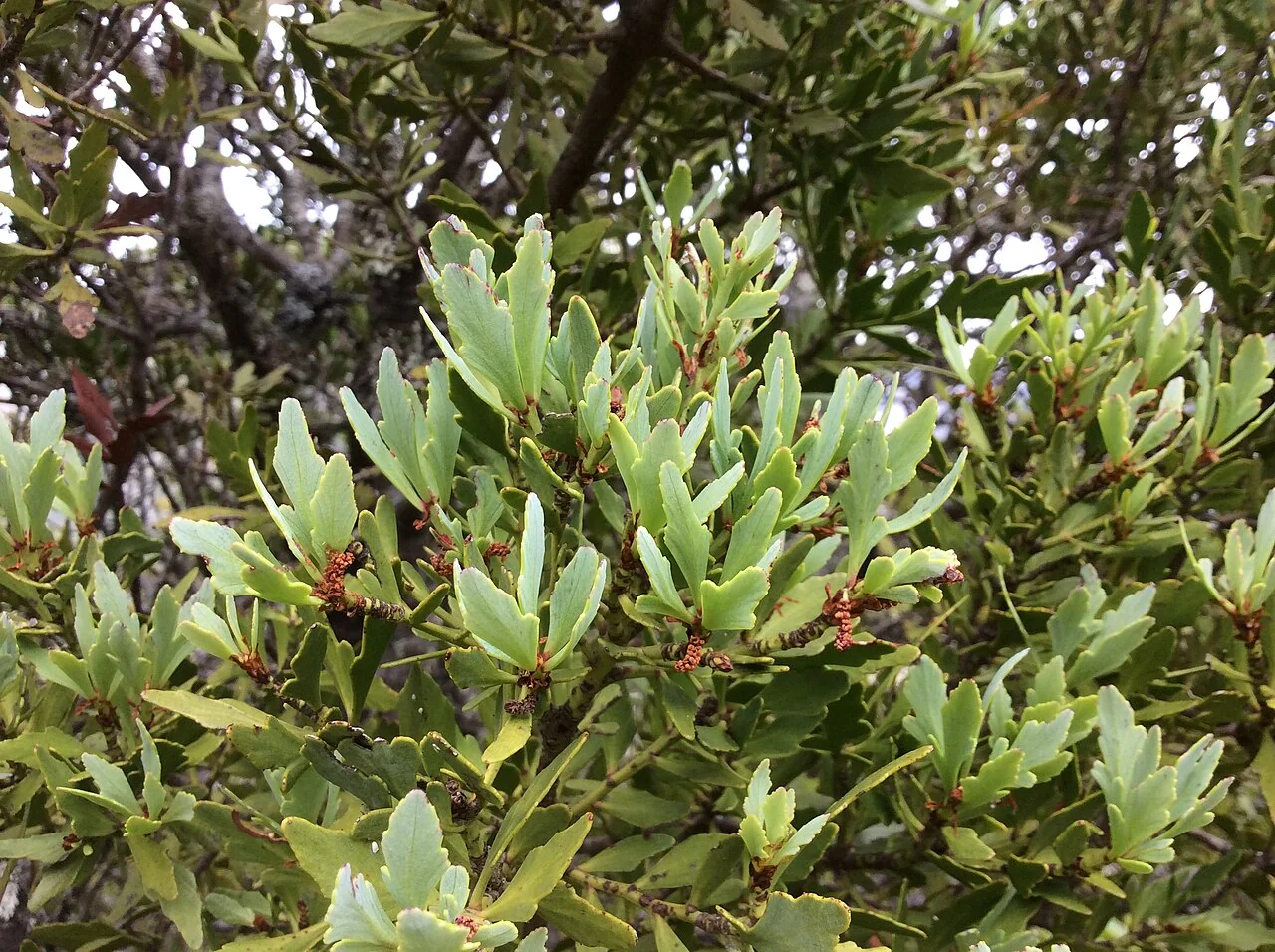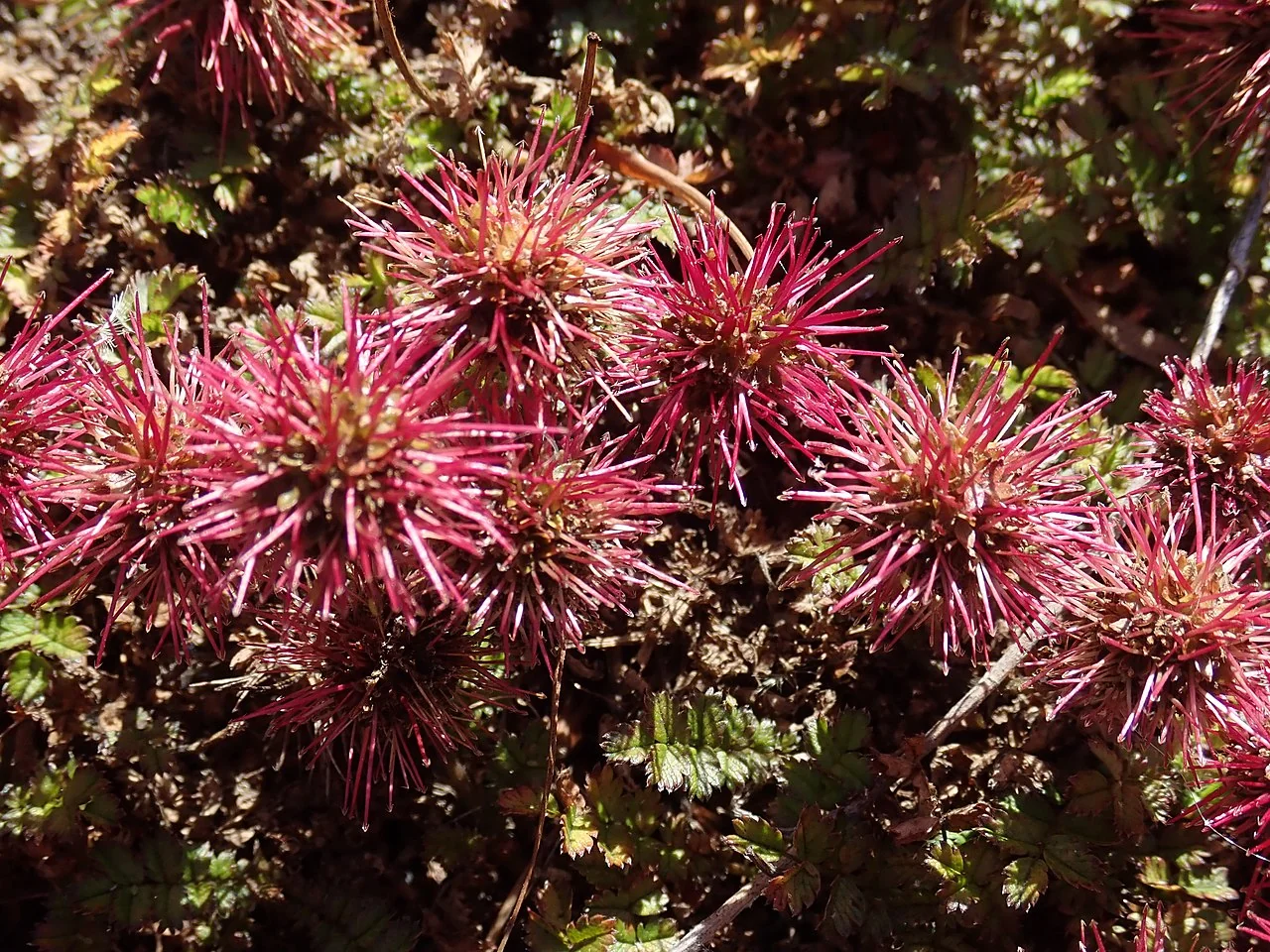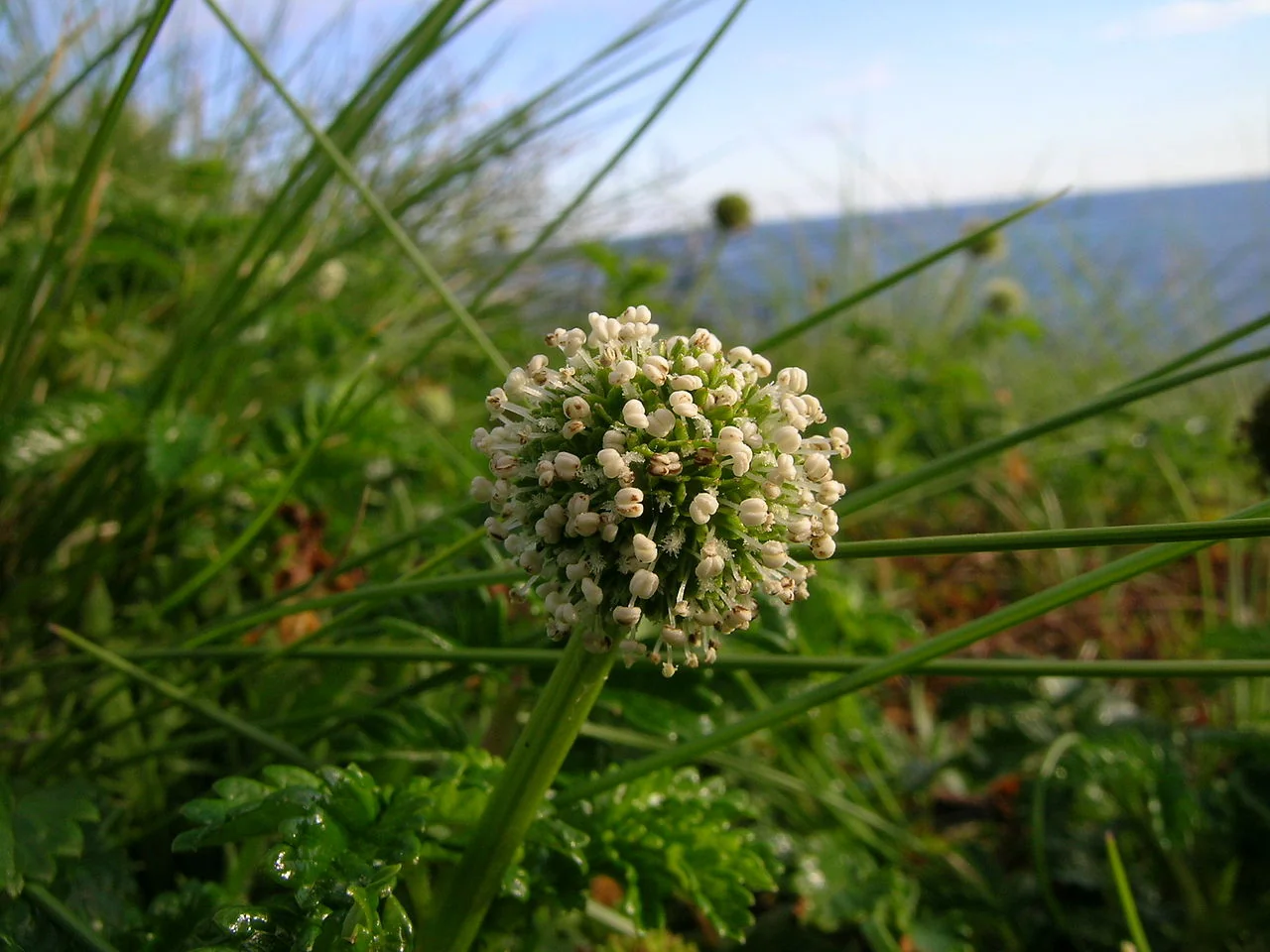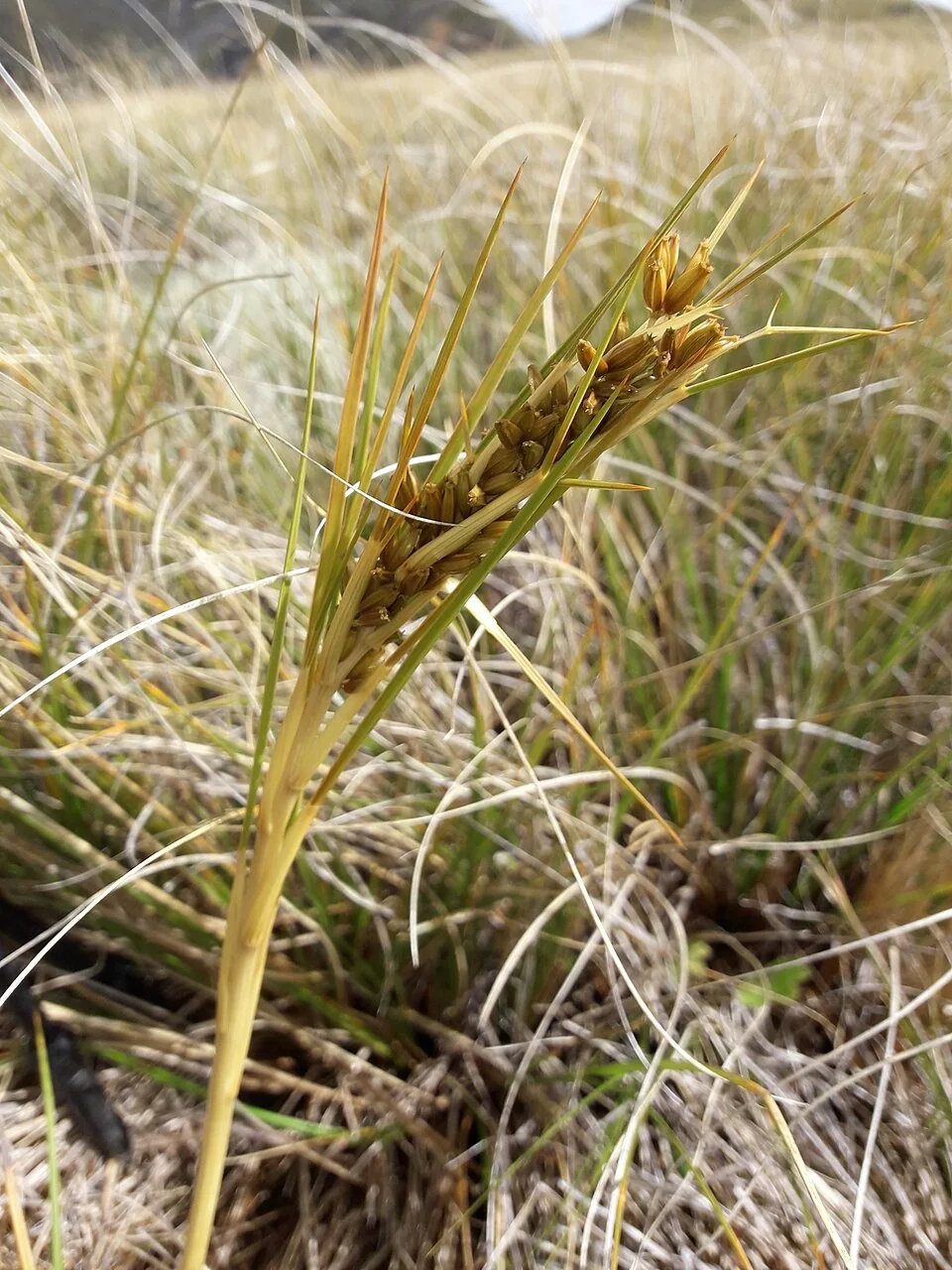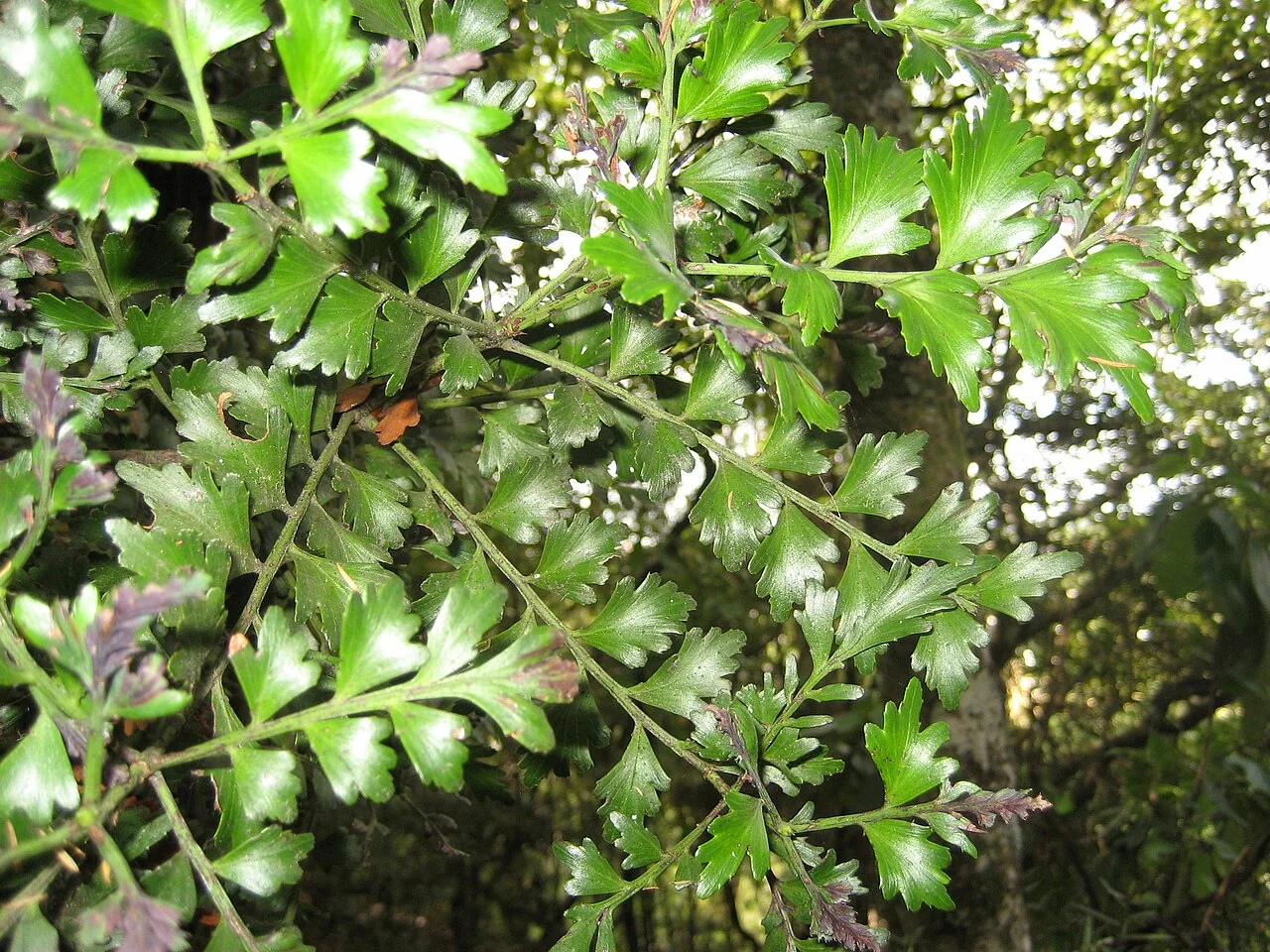
Tānekaha
Phyllocladus trichomanoides
Tānekaha is a unique evergreen conifer reaching 15-20 meters tall, distinguished by its unusual flattened leaf-like branches called phylloclades that perform photosynthesis instead of true leaves. These fan -shaped, segmented structures give the tree a distinctive fern-like appearance that sets it apart from all other New Zealand conifers . Found throughout both islands in lowland and montane forests, this remarkable species represents an ancient evolutionary adaptation among New Zealand's native trees .

Plant Description
Botanical Features
Tānekaha ( Phyllocladus trichomanoides ), also known as celery pine, is a coniferous tree endemic to New Zealand. It is a medium-sized to large forest tree, typically growing up to 20-25 meters in height, with a trunk diameter of up to 1 meter. The tree has a pyramidal shape with slender, spreading branches arranged in whorls. A distinctive feature is its phylloclades, which are highly modified, flattened, leaf-like stems that perform most of the photosynthesis. These phylloclades are arranged alternately, typically 10-15 per shoot, and are irregularly rhomboid, flabellately lobed, and cuneate at the base, measuring between 1.5 and 2.5 cm long. The margins of the phylloclades are minutely crenulate with small, subulate leaf-denticles. Juvenile plants have narrow, linear, deciduous leaves up to 20 mm long, while adult leaves are much smaller and scale-like. The species is monoecious, meaning both male and female reproductive structures are found on the same plant. Male strobili (pollen cones) are terminal, appearing in clusters of 5-10. The seed cones are berry-like, with a fleshy white aril partially enclosing a single, nut-like seed.
Quick Facts
Quick Facts Overview
| Scientific Name | Phyllocladus Trichomanoides |
|---|---|
| Height | 15-20 meters |
| Spread | 8-12 meters |
| Water Needs | Moderate |
| Light | Full sun to partial shade |
| Frost Tolerance | High (hardy to -10°C) |
| Salt Tolerance | Low |
| Growth Rate | Slow to moderate |
| Lifespan | 200-300 years |
Climate Best Suited to
Tānekaha grows naturally throughout New Zealand from sea level to 1000 meters elevation in lowland and montane forests. It prefers cool, moist conditions with good drainage and performs best in areas with moderate rainfall and protection from strong winds. This species adapts well to various climate zones but struggles in very hot or very dry conditions.
Regional Suitability
| Whangārei | Ideal |
| Auckland | Ideal |
| Hamilton | Suitable |
| Rotorua | Suitable |
| Tauranga | Ideal |
| Gisborne | Ideal |
| New Plymouth | Ideal |
| Whanganui | Ideal |
| Palmerston North | Suitable |
| Napier | Ideal |
| Wellington | Ideal |
| Nelson | Ideal |
| Christchurch | Suitable |
| Dunedin | Suitable |
| Invercargill | Suitable |
| City | Climate Suitability |
|---|
Plant Habitat
Plant Habitat Overview
This section provides important information about plant care and cultivation practices. Understanding these aspects helps ensure successful growth and development in garden conditions.
Plant Conservation
Conservation
Phyllocladus trichomanoides , commonly known as tānekaha or celery pine, is a coniferous tree native to New Zealand. Its conservation status is currently assessed as "Least Concern" by the IUCN Red List. This classification indicates that the species is not currently considered threatened, as its extent of occurrence and area of occupancy exceed the thresholds for a threatened category, and past declines have ceased, with populations increasing in many areas. The tree is found in lowland forests across the North Island and in parts of the South Island of New Zealand, often in association with kauri (Agathis australis) on ridge lines, and in secondary regrowth forests. It can grow up to 25 meters tall and is known for its strong, knot-free timber. While not currently threatened, information on its propagation and habitat is available. It can be grown from fresh seeds, though germination can be erratic. Small-scale planting trials have shown good growth in sapling stages when planted on well-drained soils in gaps within scrub.
Growing Requirements
Soil Requirements
Tānekaha prefers well-drained, fertile forest soils:
- Well-drained soils essential - cannot tolerate waterlogging
- Prefers fertile , humus-rich soils with good organic content
- Performs well in volcanic and alluvial soils
- Suitable for slightly acidic to neutral pH (5.5-7.0)
- Benefits from organic matter and leaf litter around base
Light Requirements
Tānekaha adapts well to varying light conditions:
- Full sun to partial shade (very adaptable)
- Can tolerate filtered forest light when young
- Develops best form with morning sun exposure
- Benefits from protection from harsh afternoon sun
Water Requirements
Tānekaha requires consistent moisture for healthy growth:
- Regular watering during establishment (first 2-3 years)
- Consistent soil moisture preferred but not waterlogged
- Moderate drought tolerance once established
- Benefits from mulching to retain soil moisture
- Sensitive to extended dry periods
Planting Guide
When to Plant
Plant Tānekaha during autumn or spring when soil conditions are optimal and temperatures are moderate. This species establishes best when planted during cool, moist periods that allow gradual root development.
Site Selection
Choose a site with:
- Partial shade to full sun (morning sun preferred)
- Well-drained, fertile soil with good organic content
- Protection from strong winds and extreme heat
- Space for mature size (20 m tall, 10 m spread)
Planting Procedure
- Dig hole 2-3 times wider than root ball, same depth
- Improve soil with compost and ensure excellent drainage
- Position tree so root collar sits at natural soil level
- Backfill with improved soil, watering gently as you fill
- Create shallow watering basin around tree
- Water thoroughly after planting to settle soil
- Apply 10cm layer of organic mulch around base
Initial Care
Provide consistent watering during first 2-3 years until established. Tānekaha is moderately slow-growing, so patience is required during the establishment phase.
Ecological Role
Environmental Impact
Celery pine plays important ecological roles in New Zealand's diverse forest ecosystems, where its unique phylloclade system and distinctive architecture contribute to forest structural diversity and provide specialized habitat for native wildlife. The tree supports communities of epiphytes and forest organisms, while its distinctive growth form creates specific microhabitats that contribute to forest biodiversity. Its presence in various forest types helps maintain the genetic and structural diversity that characterizes New Zealand's native coniferous forests.
Uses Section
Uses Section Overview
This versatile native plant offers multiple practical applications in landscaping and garden design, from providing ground cover and erosion control to creating habitat for native wildlife. The plant 's natural characteristics make it valuable for restoration projects and sustainable gardening practices.
Cultural Significance
Cultural Importance
Tānekaha Tannins
Tānekaha's bark is rich in tannins historically used to produce durable red-brown dyes. The straight, flexible timber has been valued for light construction and craft.
Phyllocladus trichomanoides , commonly known as Tānekaha or celery pine, holds significant cultural importance, particularly for the Māori people of New Zealand, and was also utilized by early European settlers. For Māori, Tānekaha was highly valued for its strong and flexible timber, which was used in the construction of spears (koikoi), canoes (waka), and houses. It was also crafted into items such as walking sticks, fish hooks, masts, paddles, and clubs. The tree's bark was a crucial source of a reddish-brown, colorfast dye, used for flax garments, mats, patu, kites, and even whalebone. Medicinally, Tānekaha was employed as a liver tonic and for treating ailments like dysentery, vomiting, internal hemorrhage, ulcers, burns, boils, abscesses, septic infections, and menstrual pain, often applied topically as an astringent. The leaves were also used to line the graves of the deceased, symbolizing the spirit of Tane. The Māori name "Tānekaha," meaning "Strong Man," reflects the timber's inherent strength and durability. In some areas, large Tānekaha trees were so revered that they were given individual names, and access to their bark was restricted to those with direct ancestral ties to the land. Early European settlers also recognized the practical value of Tānekaha. Its robust timber was used for marine piles, bridge decking, railway sleepers, pit props, heavy roof timbers, housing, and components for agricultural machinery like hay sweeps. Both Tānekaha timber and bark were exported internationally in the 19th and early 20th centuries, with the bark being used in Europe for tanning leathers, particularly for glove-making, and even for dyeing khaki uniforms during World War I.
Landscaping Section
Landscaping Section Overview
This section provides important information about plant care and cultivation practices. Understanding these aspects helps ensure successful growth and development in garden conditions.
Seasonal Care Calendar
Spring
- New phylloclade growth emerges with fresh green colour
- Best planting time for new specimens
- Apply organic mulch to retain soil moisture
- Begin regular watering schedule for young trees
Summer
- Active growth period for phylloclades and branches
- Monitor soil moisture during dry periods
- Male trees produce pollen, females develop seed cones
- Provide shade protection for newly planted specimens
Autumn
- Seeds mature on female trees with distinctive red arils
- Good time for planting before winter
- Collect seeds for propagation when available
- Natural phylloclade drop occurs (normal cycle)
Winter
- Growth slows with dormancy period beginning
- Excellent frost tolerance, no protection needed
- Best time for any necessary structural pruning
- Reduce watering frequency during dormant period
When to Prune and How Much
When to Prune and How Much Overview
Tānekaha naturally develops excellent form and requires minimal pruning:
- Remove dead , diseased, or damaged branches as needed
- Light structural pruning for young trees to establish good leader
- Avoid heavy pruning of phylloclades as they don't regenerate easily
- Late winter to early spring is best timing for any pruning
- Preserve natural conical form for best appearance
Use sharp , clean tools and make precise cuts. The unique phylloclade structure means pruning should be conservative to maintain the tree's distinctive appearance.
How to Grow Tānekaha
Tānekaha is a unique evergreen conifer reaching 15-20 meters tall, distinguished by its unusual flattened leaf-like branches called phylloclades that perform photosynthesis instead of true leaves. These fan-shaped, segmented structures give the tree a distinctive fern-like appearance that sets it apart from all other New Zealand conifers. Found throughout both islands in lowland and montane forests, this remarkable species represents an ancient evolutionary adaptation. Understanding its propagation methods is key to successfully growing this unique species.
From Seed
Propagating Tānekaha from seed requires patience and specific conditions due to its slow germination and growth rates. Collect ripe seeds with red arils from female plants in autumn (note that fruiting is not annual). Remove the fleshy aril coating and clean seeds thoroughly. Stratify seeds in moist sand at 4°C for 10-12 weeks to break dormancy. Sow stratified seeds in a very well-drained seed mix. Maintain cool, consistent conditions (16-20°C) with excellent drainage. Germination is irregular and slow, often taking 8-16 weeks. Transplant seedlings when robust enough to handle (10-15cm tall and well-rooted). Seedlings are very slow-growing and may take 15-25 years to reach maturity.
From Cuttings
Vegetative propagation of Tānekaha from cuttings is very challenging and generally has low success rates. Take small semi-hardwood cuttings from current year's growth. Use rooting hormone treatment and an extremely well-drained cutting mix. Provide cool, humid conditions with excellent air circulation. Success rates are very low due to specialized requirements, and rooting may take 6-12 months when successful. Growth is extremely slow once rooted. This method is best suited for experienced propagators or in specialized nurseries for conservation purposes.
Pests and Diseases
Root Rot Diseases
- Cause: Poor drainage leading to Phytophthora and other soil-borne pathogens
- Symptoms: Yellowing phylloclades , branch dieback, reduced vigor
- Management: Ensure excellent drainage; avoid overwatering; improve soil structure
Phylloclade Browning
- Cause: Environmental stress from drought, heat, or nutrient deficiency
- Symptoms: Brown edges on phylloclades, premature drop
- Management: Maintain consistent soil moisture; provide partial shade in hot locations
Scale Insects
- Damage: Sap-sucking insects on phylloclades and stems
- Symptoms: Sticky honeydew , yellowing phylloclades, reduced growth
- Management: Horticultural oil sprays; encourage beneficial insects; maintain tree vigor
Possums and Browsing
- Damage: Possums may browse on distinctive phylloclades
- Symptoms: Chewed phylloclades , damaged growing tips
- Management: Install tree guards on young trees; possum control in affected areas
Tānekaha's unique structure makes it relatively resilient to most pests. Focus on providing optimal growing conditions to maintain natural disease resistance.
Bonus Tip
Expert Growing Advice
Tānekaha gets its common name "celery pine" because most of its photosynthesis is performed by flattened, leaf-like branches called phylloclades, which resemble celery leaves, rather than its tiny true leaves.
